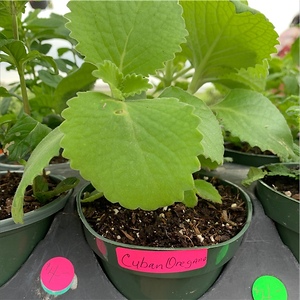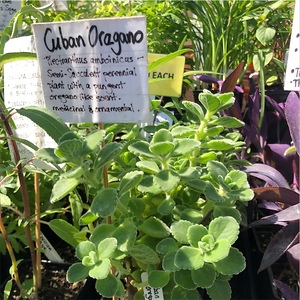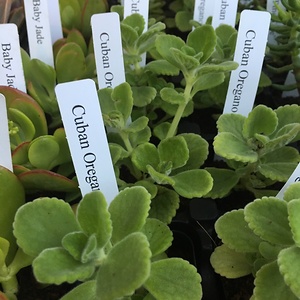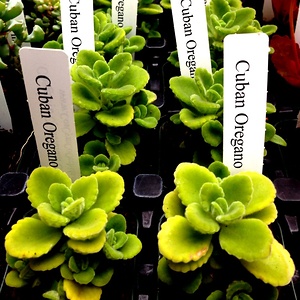

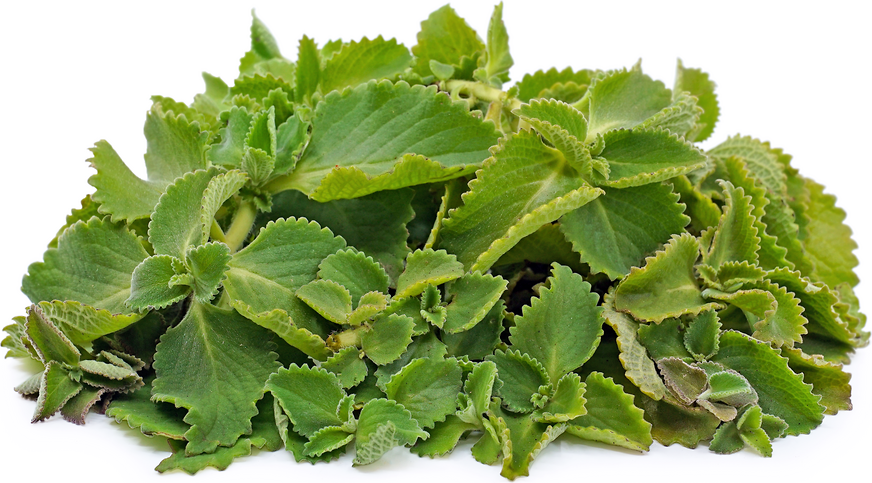
Cuban Oregano
Estimated Inventory, bunch : 0
Description/Taste
Cuban oregano is a hardy, succulent herb. It has a stem similar to that of a succulent with new growth offering more delicate green stems. Cuban oregano leaves are rounded, thick, and velvety and grow in pairs around the stem. The leaves are green and serrated along the edges, though some varieties have a variegated color and more deeply-toothed margins. Cuban oregano has a strong, pungent and musky aroma, with a flavor profile that is similar to traditional Italian oregano with a hint of thyme.
Seasons/Availability
Cuban oregano is available year-round.
Current Facts
Cuban oregano is botanically known as Plectranthus amboinicus or its synonym Coleus amboinicus, and is an unusual member of the mint family. Cuban oregano is commonly known by many other names including Mexican mint, Spanish thyme, Indian borage, Caribbean oregano, and Broadleaf thyme. Contrary to its name, Cuban oregano is believed to have originated in India.
Nutritional Value
Cuban oregano contains high amounts of ascorbic acid, or vitamin C, vitamin A, and the essential fatty acid, omega-6. It also contains compounds that have anti-inflammatory properties. Cuban oregano also contains properties that can neutralize the capsaicin in hot peppers.
Applications
Cuban oregano can be used in place of other oregano varieties, thyme or other herbs with a similar flavor profile. The pungent aroma and strong flavor of Cuban oregano pairs well with meat and fish. Stuff pork with fresh Cuban oregano or use to marinate chicken or beef. Cuban oregano can also be sautéed along with assorted vegetables, or added to soups and stews as an aromatic. Store unwashed Cuban oregano in a plastic bag in the refrigerator for up to a week.
Ethnic/Cultural Info
Cuban oregano is often found in the local cuisines in Cuba, India and the Philippines. In the West Indies, which includes Haiti, Puerto Rico and smaller islands, Cuban oregano is added to traditional ‘jerk’ seasoning blends, bean dishes and salsas. The succulent herb has been used in Ayurvedic practices for centuries in India and throughout Indonesia, prescribed as an expectorant, anti-inflammatory, to induce sweating to relieve a fever and as a diuretic.
Geography/History
The origin of Cuban oregano may be traced using its scientific name, Plectranthus amboinicus. The Latin name of the species ‘amboinicus’ may refer to Ambon, a small but fertile, mountainous island in Indonesia. Cuttings were likely spread to Africa, the West Indies and Latin America and propagated by Spanish explorers and travelers. There is a dispute regarding its origin - some claim Cuban oregano is native to eastern Africa. Despite the claims, Cuban oregano has existed in the coastal regions of the countries surrounding the Indian Ocean for centuries. A hardy plant, Cuban oregano grows well in USDA Zones 10 and 11.
Recipe Ideas
Recipes that include Cuban Oregano. One
| Ruchik Randhap |
|
Sambarpalli Chutney- Indian Borage/Cuban Oregano Chutney |
| CSA Produce Recipes |
|
Grilled Chicken using Cuban Oregano |
| Ruchik Randhap |
|
Indian Borage / Cuban Oregano Fritters |







